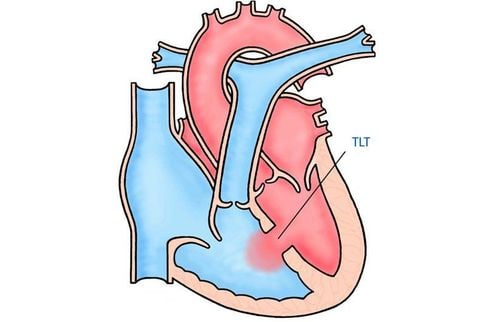This is an automatically translated article.
The article was professionally consulted with Master, Doctor Do Nguyen Thuy Doan Trang - Cardiovascular Center - Vinmec Central Park International General Hospital.According to statistics, for every 1,000 babies born, there are 8 children with congenital heart disease. If there is no indication and timely congenital heart surgery, it can cause serious effects on the health of the child, even death.
1. What is congenital heart disease?
Congenital heart disease in children is a condition in which the heart has malformations from birth. The heart structure is defective, which affects the functioning and function of the heart, the body's blood circulation also works abnormally. Congenital heart disease is classified as the most common type of birth defect, and it is also one of the leading causes of death in birth defects. With the development of modern medicine, today congenital heart disease can be detected through ultrasound technology at 18 weeks of pregnancy.
2. Some common congenital heart diseases
As for the ductus arteriosus, usually, the ductus arteriosus that exist in the fetus will close within the first 2 weeks to 1 month after the baby is born. However, there are cases where the duct does not close after the above time, called a ductus arteriosus. Premature babies are at high risk for this form of birth defect.Ventricular septal defect, atrial septal defect On the septum between the two atria and/or ventricles, there is an abnormal opening. Depending on the size and location of the stoma, there is an appropriate treatment. For ventricular septal defects, very small atrial septal defects may not require surgical intervention but still need periodic monitoring. In contrast, large holes are surgically patched or closed with an instrument.
Coarctation of the aorta The isthmus of the aorta is abnormally narrow, resulting in impeded blood flow to the body.
Heart valve abnormalities Some newborns with valvular stenosis, valvular regurgitation, or congenital valvular atrophy require early intervention or surgery.
Tetralogy of Fallot is a condition in which the blood that feeds the body is mixed blood caused by 4 congenital heart abnormalities. Children with tetralogy of Fallot often have cyanosis symptoms from birth to varying degrees. Right from the first months after birth, babies can be treated with surgical repair.
3. Indications and timing of congenital heart surgery

No need for surgery: This group only includes a small number of congenital heart diseases at an early stage or mildly such as small foramen septal defect, small ventricular septal defect, stenosis or mild valvular regurgitation without complications. However, patients still need to be re-examined every 6 months to closely monitor the progression of the disease. Need surgery: Including most cases of congenital heart disease or when the disease has progressed to moderate to severe or when surgery is indicated by the doctor in the first place. Specifically, such as: pulmonary hypertension, aortic regurgitation, severe aortic stenosis, left heart hypoplastic syndrome, severe coarctation of the aorta, transposition of the great arteries, common trunk, APSI , APSO, abnormal pulmonary vein obstruction, ... Inoperable group: Are cases of congenital heart disease but detected at too late stage, has progressed very seriously and has severe symptoms. The damage is too complex to be treated. Indications and timing of surgery for some specific congenital heart diseases
And ductus arteriosus Currently, endovascular intervention (without surgery) to occlude the ductus arteriosus has very good results and is the main choice. weak for cases with ductus arteriosus. However, large ductus arteriosus is indicated for intervention within 1 month of age, it is necessary to conduct closed heart surgery, cut the ductus arteriosus.
Atrial septal defect The patient is indicated for instrument closure or open heart surgery to repair the combined lesion (mitral regurgitation, pulmonary stenosis, partial ectopic pulmonary vein) and closure of the atrial septal defect. Perform surgery when:
Pulmonary artery pressure rises higher than 30mmHg Qp / Qs > 1.5 There are combined lesions Note age when surgery is indicated under 5 years old (before school or before adulthood) , preferably between 1-2 years of age Ventricular septal defect Surgery to repair combined lesions (aortic regurgitation, right ventricular outflow tract stenosis, Valsalva sinus aneurysm and rupture,...) and closure of the ventricular septal defect. Indications to conduct when:
Symptomatic megaloblastic septal defect Before 3 months of age: large foramen septal defect with congestive heart failure or respiratory symptoms ventricular septal defect in the funnel, under 2 aortic valves or Valsalva sinus aneurysm. There are associated lesions or complications: aortic regurgitation, ruptured aneurysms of Valsalva, Osler, stenosis of the right ventricular outflow tract. Tetralogy of Fallot Patients with the type of congenital heart disease Tetralogy of Fallot need intervention as soon as possible. Diagnosis is surgical indication. Usually a total open-heart surgery. Mild and non-severe symptoms: complete surgical repair from 3 months of age. However, for children who are too young, small pulmonary artery branches, severe disease can perform temporary surgery for aortopulmonary bypass.
To protect cardiovascular health in general and detect early signs of congenital heart disease, customers can sign up for Cardiovascular Screening Package - Basic Cardiovascular Examination of Vinmec International General Hospital. The examination package helps to detect cardiovascular problems at the earliest through tests and modern imaging methods. The package is for all ages, genders and is especially essential for people with risk factors for cardiovascular disease.
Please dial HOTLINE for more information or register for an appointment HERE. Download MyVinmec app to make appointments faster and to manage your bookings easily.














